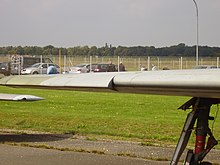Saw tooth (aerodynamics)

In aerodynamics, a sawtooth is an aerodynamic assembly on the wing or tail surfaces , which influences the flow above all over the outer areas at high angles of attack . The name comes from the serrated (tooth-like) design of the front edge.
Mode of action
When flying at high angles of attack, the airflow is released on wings of small extension in the outer area. This leads to loss of aerodynamic lift and effectiveness of the control surfaces. In order to stabilize the external flow, a new (leading edge) vortex is generated via the so-called sawtooth on the leading edge. This brings additional energy into the separating flow and thereby stabilizes it. The aircraft can fly at higher angles of attack and has better maneuverability in this flight area.
Saw teeth are mainly found on older aircraft .
More options
In addition to saw teeth, there are other ways to stabilize the flow above the wing, especially above the outer area:
Examples
- Different types of aircraft with saw teeth in the aerodynamic design





